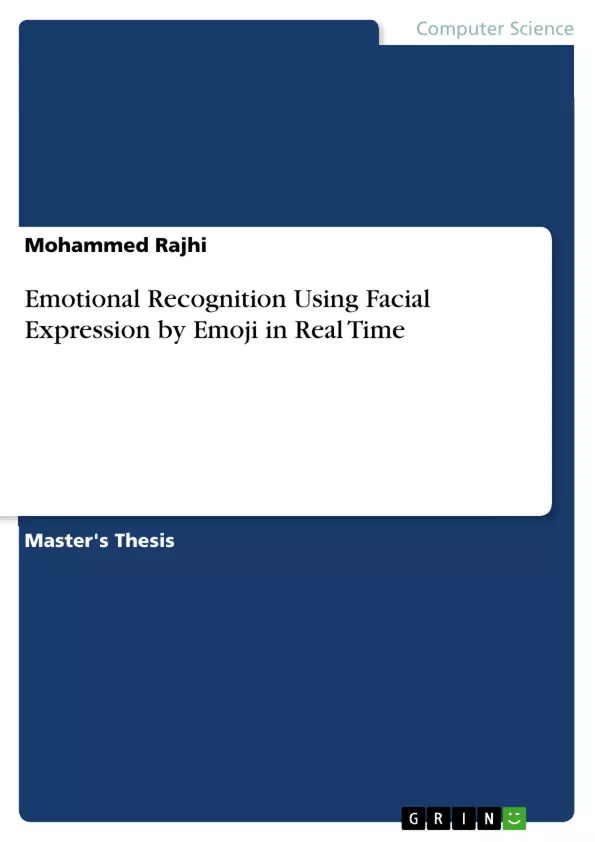Present research focuses on the role of emoji’s in facilitating emotional recognition with the help of pictorial depictions of facial expressions. Today is the era of fast and dynamic internet and communication technologies. Hence, the communication is convenient as compared to the past. Use of communications through different channels, such as mobile phones and computers, are very common in today’s era. E-mails, text messaging, blog entries, and comments are some of the forms of communication which are very common today. To enhance the experience of communication, emojis were developed by the Japanese mobile companies such as Vodafone. Emoji’s are the pictorial depiction of the facial expression of human beings. They are very helpful in the facilitation of human emotional experiences.
This research thesis investigates emotional recognition using facial expression by emoji in real time. Moreover, it also develops the parameters of measuring the facial expression and understanding the facial emotion recognition in real time. The application developed includes six human expressions, which include neutral, fear, anger, happy, sad, and surprise emotions. These expressions are the actual expressions which are being conveyed in human beings. The investigations of such expression are important because of their ability to better express human emotions and the way they facilitate communications among the people. Recommendations on further research will be provided for researchers.
Table of Contents
- Chapter 1: Introduction
- 1.1 Introduction
- 1.2 Objectives
- 1.3 Background
Objectives and Key Themes
The main objective of this thesis is to investigate emotional recognition using real-time facial expressions depicted by emojis. It aims to develop parameters for measuring facial expressions conveyed through emoji texting and to understand real-time facial emotion recognition. The research focuses on six basic human emotions: neutral, fear, anger, happiness, sadness, and surprise.
- Real-time emotional recognition through emoji-based facial expressions.
- Development of parameters for measuring facial expressions using emojis.
- Understanding real-time facial emotion recognition.
- The role of emojis in facilitating human communication and emotional expression.
- Application of visual technology and convolutional neural networks (CNNs) in emotion recognition.
Chapter Summaries
Chapter 1: Introduction: This chapter introduces the research topic of emotional recognition using emojis in real time. It highlights the importance of emotional recognition in human communication and discusses the challenges involved in accurately identifying emotions through visual cues. The chapter establishes the objectives of the research, which include investigating real-time emotional recognition through emojis, developing parameters for measuring facial expressions using emojis, and understanding real-time facial emotion recognition. It also provides a brief overview of existing research and techniques used in facial emotion recognition, including the use of convolutional neural networks (CNNs) and the challenges associated with limited data and variations in illumination. The chapter sets the stage for the subsequent exploration of the research methodology and results.
Keywords
Emotional recognition, facial expression, emojis, real-time analysis, convolutional neural networks (CNNs), human-computer interaction, communication technology, visual communication, emotion detection, affective computing.
FAQ: Comprehensive Language Preview - Emotional Recognition using Emojis
What is the main topic of this document?
This document provides a comprehensive preview of a research project focusing on real-time emotional recognition using emojis as indicators of facial expressions. It details the objectives, key themes, chapter summaries, and keywords of the research.
What are the main objectives of the research?
The primary objective is to investigate real-time emotional recognition through emoji-based facial expressions. This involves developing parameters for measuring these expressions and understanding the process of real-time facial emotion recognition. The research specifically focuses on six basic emotions: neutral, fear, anger, happiness, sadness, and surprise.
What key themes are explored in the research?
Key themes include the role of emojis in communication and emotional expression, the application of visual technology (specifically convolutional neural networks or CNNs) in emotion recognition, and the challenges of accurately identifying emotions through visual cues.
What is covered in Chapter 1: Introduction?
Chapter 1 introduces the research topic, highlighting the importance of emotional recognition in communication and the challenges involved. It outlines the research objectives, provides a brief overview of existing research and techniques (including CNNs), and discusses challenges like limited data and varying illumination. It sets the stage for the methodology and results.
What keywords are associated with this research?
Keywords include: Emotional recognition, facial expression, emojis, real-time analysis, convolutional neural networks (CNNs), human-computer interaction, communication technology, visual communication, emotion detection, and affective computing.
What emotions are specifically examined in the research?
The research focuses on six basic human emotions: neutral, fear, anger, happiness, sadness, and surprise.
What technologies are used in this research?
The research utilizes convolutional neural networks (CNNs) as a key technology for emotion recognition from visual data (emojis).
What is the overall purpose of this preview?
This preview serves as a concise summary of the research project, providing key information for understanding its scope, methodology, and findings.
- Quote paper
- Mohammed Rajhi (Author), 2017, Emotional Recognition Using Facial Expression by Emoji in Real Time, Munich, GRIN Verlag, https://www.grin.com/document/379502



